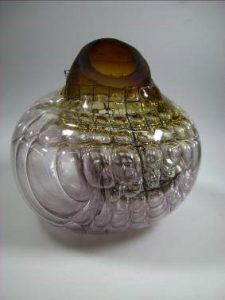Jörg Zimmermann: Honeycomb Object - German/German

Jörg F. Zimmermann, born in Uhingen near Göppingen in 1940, is a glass cutter, glass painter, designer and visual artist. Since 1983 he has taught at the Bildende Akademie in Stuttgart at the only academic glass melting furnace in Baden-Württemberg. Zimmermann's honeycomb objects enjoy world fame. Some have long been part of the studio glass collection of the Glass Museum.
Zimmermann's leitmotif, which underlies all the honeycomb objects, is the illustration of principles of order. Actually, he only wants to make the inner structure visible and show what the intervention from the outside can mean for the inside. For Zimmermann, the metal grid through which he blows the hot glass mass and the cell-like rows of bubbles brought about by the grid are merely an adequate means of design that he finds confirmed in nature: More importantly, the grid and the rows of bubbles make visible the process of creation typical of studio glass.
Zimmermann shapes the glass into a large bubble at the glassmaker's pipe. He then cuts it in two with a diamond saw. This exposes the inner structure. He injures it and works on it with a sandblasting blower. By means of the coloured glass overlays melted on the inside, he projects the relief of the grid to the outside. In this way, the honeycomb objects become complex symbols of the danger and vulnerability of the delicate inner structure of our world.
Jörg Zimmermann: Honeycomb Object - English

Jörg F. Zimmermann, born in 1940 in Uhingen near Göppingen, is a glasscutter, glass painter, designer and a visual artist. He has been teaching at the visual arts Academy in Stuttgart using the only glass furnace used for academic purposes in the state of Baden-Württemberg, since 1983. Zimmermann's mesh or honeycomb objects enjoy world fame and we have had some of these in our studio glass collection for a long time.
Zimmermann's leitmotif that underlies all of his honeycomb objects is the illustration of a principle of order. All he wants to do is to make the inner structure visible and demonstrate what an external intervention can mean for the internal. Zimmermann considers the metal mesh that he uses to blow the hot glass through and the cell-like rows of bubbles that it creates an adequate design medium that is reiterated in nature and more importantly, the mesh and the rows of bubbles make the creation process so typical of studio glass, visible.
Using a glassblowers' pipe, Zimmermann shapes the glass into a large bubble. He then cuts it in half with a diamond saw and thus exposes the inner structure. He damages it and processes it was a sandblaster and he projects the form of the mesh to the outside by using fused coloured glass layers on the inside. In this way his honeycomb objects become a complex allegory for the danger and vulnerability of our sensitive internal world.